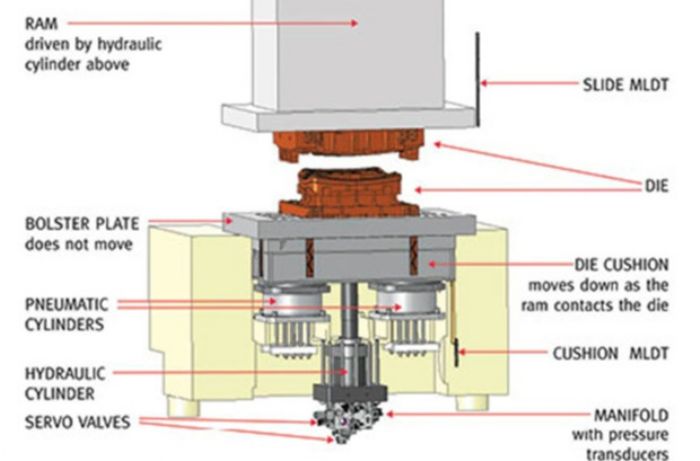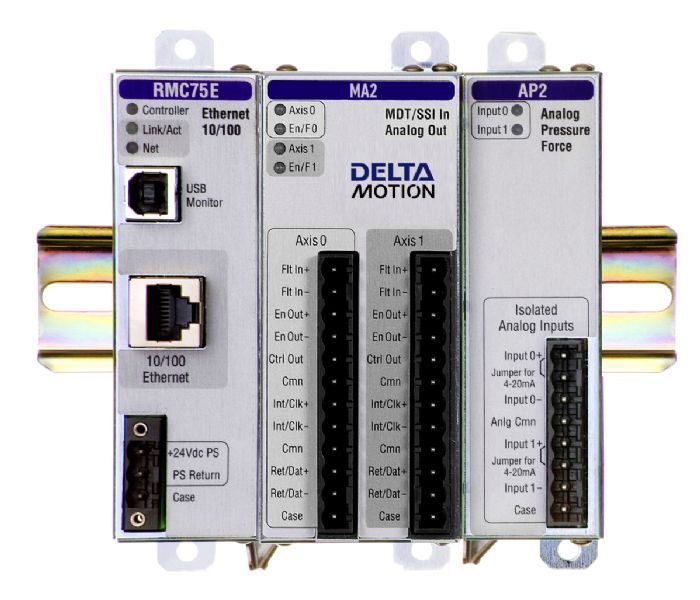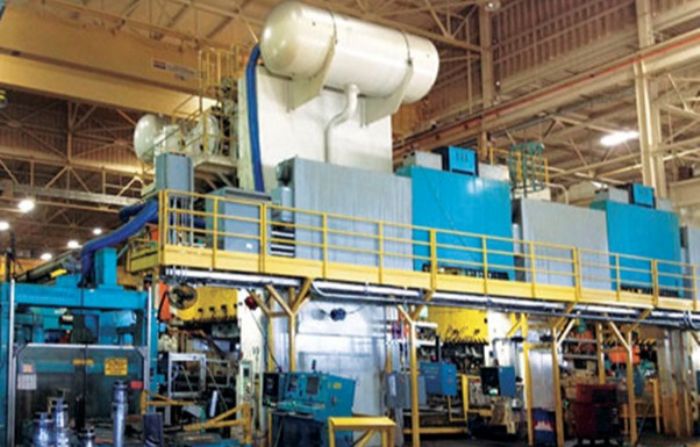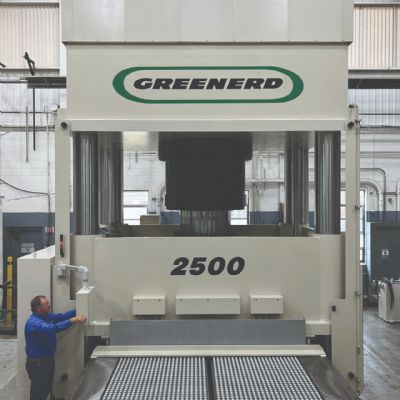 “We had to take the motion of the existing ram into account to make sure that the new cushion could work with it,” says Tom Pedersen, Dayton Die Cushions manager. “The old press had a distorted bed, and we needed to align the structure before we could add our hardware. We reconstituted the bed with adjustable guides that we aligned with a 3D laser to within 0.001 in.”
“We had to take the motion of the existing ram into account to make sure that the new cushion could work with it,” says Tom Pedersen, Dayton Die Cushions manager. “The old press had a distorted bed, and we needed to align the structure before we could add our hardware. We reconstituted the bed with adjustable guides that we aligned with a 3D laser to within 0.001 in.”
And, the new die cushion needed to contact the workpiece with the press ram already in motion and moving at a very high velocity, which in turn required the hydraulics to act before the ram contacted the die. This contrasts with traditional press operations, where the ram hits the cushion before the cushion moves, with the contact causing hydraulic pressure to spike and generating an error in the closed-loop algorithm, which produces a response according to the algorithm. However, such a method would not work in the press application at Spartanburg Steel Products.
“We couldn’t tolerate the collision,” Pedersen explains. “Instead, we looked for a way to predict the collision and take action prior to the ram hitting the workpiece.”
Another challenge: responsiveness of the valve. Should the cushion’s hydraulic controller wait too long to begin increasing oil flow to the valve, the time lag could damage the workpiece. The hydraulic oil must be moving in time to move the cushion just as the ram readies to make contact.
 Dayton Die Cushions’ solution to this challenge: a programmable motion controller that could set up a virtual motion axis to which a physical axis could be geared. ‘Gearing’ refers to the ability of the motion of a slave axis to follow a master axis, which can be another physical axis or a virtual axis that exists only within the motion controller.
Dayton Die Cushions’ solution to this challenge: a programmable motion controller that could set up a virtual motion axis to which a physical axis could be geared. ‘Gearing’ refers to the ability of the motion of a slave axis to follow a master axis, which can be another physical axis or a virtual axis that exists only within the motion controller.
“We created a virtual closure of the die-cushion control loop before the ram hits the cushion,” Pedersen says, “which no one had done before.”
With the virtual control loop closed, oil flow initiates before the die cushion contacts the ram, thus the two hydraulic systems come together smoothly, even with the ram moving quickly and with tremendous kinetic energy.
To achieve high dynamics, the team at Dayton Die Cushions selected a servo valve with high flow but very low mass. Other objectives: minimize the volume of oil flow, reduce the size of the hydraulic power unit and reduce oil conditioning, i.e., cooling, filtering, etc. Constructing this die-cushion application entirely with hydraulics would add difficulty in ensuring movement of enough hydraulic oil in the volume and time required, as the cushion measures 125 by 69 in. and must provide 250 tons of maximum holding force. As a result, Pedersen and his team incorporated two passive pneumatic cylinders beside the hydraulic cylinder (Fig. 2) to reduce the amount of hydraulic oil to be moved. The pneumatic cylinders provide the base tonnage of the cushion, and the hydraulic cylinder provides the variable tonnage that assists in shaping the workpiece.
To implement the hydraulic controls, Aleksandra Spiess, an engineer at Dayton Die Cushions, selected an RMC75 electrohydraulic motion controller (Fig. 3) from Delta Computer Systems, Inc.
“The RMC75 can run four separate task-execution engines simultaneously,” Pederson explains, noting that within Delta’s RMCTools software, each task also can run any of several user programs, one at a time. “We assigned one of the tasks to be a dedicated computation engine working in the background. A PLC wouldn’t have been fast enough to perform like the RMC.”
The motion controller connects to two servo valves, with each assigned to a separate control axis of the RMC75, which can control as many as two axes simultaneously and independently.
“If needed, we can move extra oil to the tank in order to quickly move the die cushion,” Pedersen says. “The ram moves quickly when the cushion first hits, and then slows down as the compression operation completes.”
Correct Pressure Timing a Must
The new die cushion uses two Balluff magnetostrictive linear displacement transducers (LDTs) with synchronous serial-interface inputs to the Delta motion controller and Hydac high-speed pressure sensors. One LDT measures ram position and the other measures cushion position. Just prior to the ram contacting the cushion, the RMC75 opens the valves and begins moving oil through the manifold. Then, at ram contact the RMC75 runs a pressure-control loop as the cushion descends. At the bottom of the press stroke, as the ram reverses direction and ascends, the RMC is programmed to switch to position-control mode. This causes the die cushion to rise quickly, just in time to meet a robotic arm that picks the finished part out of the die.
“The cushion must ascend in a certain time window, repeatably, to meet the transfer arm,” says Pedersen. “This required adaptive closed-loop control occurs as the temperature and, hence, the flow properties of the hydraulic oil are changing dynamically.”
Another challenge met by the Delta controller: the ability to work with existing off-the-shelf valves used by Dayton Die Cushions, as lead times for manufacture of new valves stretched too long to meet project goals.
The Dayton Die Cushions team undertook three iterations to complete the motion-control program for the Delta controller.
“As we went through the iterations, Delta’s engineers provided tremendous help,” Pedersen says. “For example, they taught us how to use the RMC75’s S-curve instruction, which initiates a smooth acceleration and deceleration to avoid hydraulic shock. They also helped to incorporate feed-forward parameters into the control loop—predictive terms that help speed response of the control algorithm.”
The team used Delta’s RMCTools Plot Manager software to prove the functionality of the system graphically and optimally tune the control-loop gains. Saving time in completing the design was important, as Spartanburg Steel Products sought to add tooling quickly in support of part production for the new automotive model year.
The die cushion design developed by Dayton Die Cushions provides an example of how hydraulic control systems have become smarter in order to meet the increased productivity and quality demands of modern automotive manufacturing. A key component of the new machines making this possible: the programmable electro-hydraulic motion controller. MF
Industry-Related Terms: Bed,
Die Cushion,
Die,
Hardware,
LASER,
Model,
Periphery,
Ram,
Run,
Stroke,
TransferView Glossary of Metalforming Terms
See also: Delta Motion
Technologies: Stamping Presses
 To perform the process as quickly as possible requires innovation in setting up the control algorithm. Dayton Die Cushions, Eden Prairie, MN, undertakes such innovation, as the following example shows.
To perform the process as quickly as possible requires innovation in setting up the control algorithm. Dayton Die Cushions, Eden Prairie, MN, undertakes such innovation, as the following example shows.






 “We had to take the motion of the existing ram into account to make sure that the new cushion could work with it,” says Tom Pedersen, Dayton Die Cushions manager. “The old press had a distorted bed, and we needed to align the structure before we could add our hardware. We reconstituted the bed with adjustable guides that we aligned with a 3D laser to within 0.001 in.”
“We had to take the motion of the existing ram into account to make sure that the new cushion could work with it,” says Tom Pedersen, Dayton Die Cushions manager. “The old press had a distorted bed, and we needed to align the structure before we could add our hardware. We reconstituted the bed with adjustable guides that we aligned with a 3D laser to within 0.001 in.” Dayton Die Cushions’ solution to this challenge: a programmable motion controller that could set up a virtual motion axis to which a physical axis could be geared. ‘Gearing’ refers to the ability of the motion of a slave axis to follow a master axis, which can be another physical axis or a virtual axis that exists only within the motion controller.
Dayton Die Cushions’ solution to this challenge: a programmable motion controller that could set up a virtual motion axis to which a physical axis could be geared. ‘Gearing’ refers to the ability of the motion of a slave axis to follow a master axis, which can be another physical axis or a virtual axis that exists only within the motion controller. 
